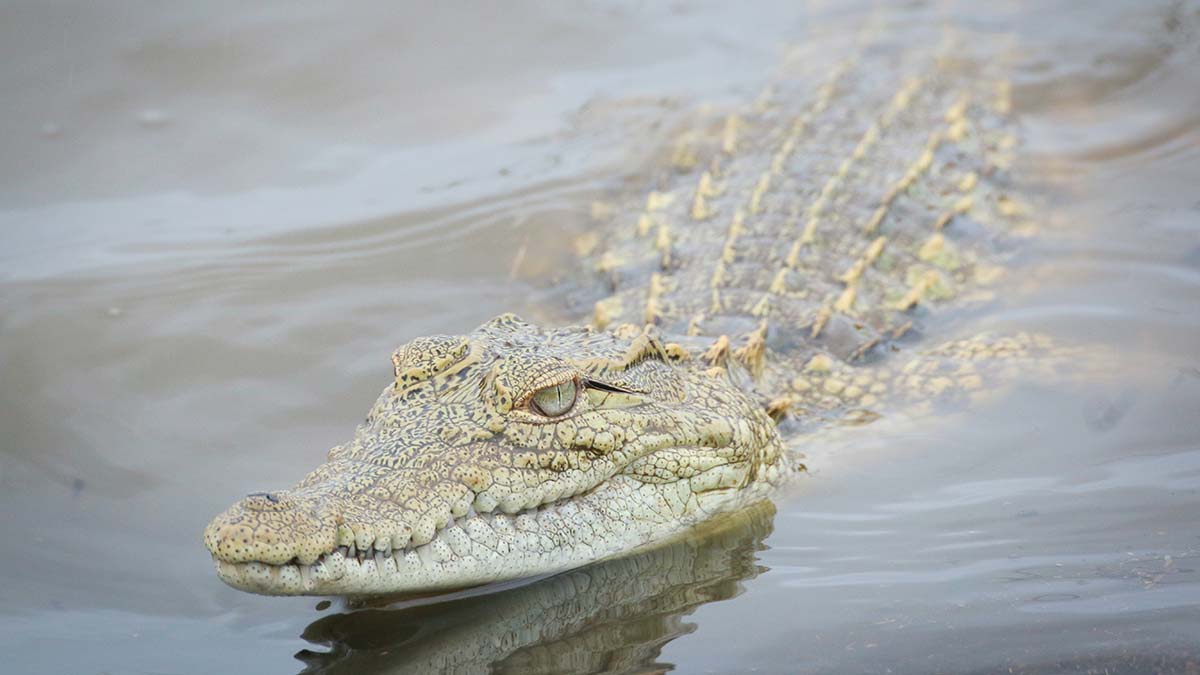
by W. Ruth Kozak
Along with a small group of other travelers I board a cruise ship at Aswan, Egypt to sail down the Nile on an adventure that will take me to visit various archaeological sites. For me this journey is like a dream come true. An avid arm-chair archeologist and historical fiction writer, I have always wanted to visit Egypt. Now here I am on the deck of a cruise ship, sailing down the mighty Nile River.
The Nile River is the world’s longest river, flowing through eleven countries approximate 4,665 miles out of the heart of Africa, northward to the Mediterranean Sea. There are two sources: The White Nile in equatorial Africa rises from the Great Lake region of central Africa is the headwater. The Blue Nile begins in Ethiopia and flows into Sudan. The two rivers meet at Khartoum. The north section flows mostly through desert from Sudan to Egypt ending at a large delta that empties into the Mediterranean Sea. The cataracts are a progression of white rapids form the southern border of Egypt at Sudan. The First Cataract is at Aswan.
Cruising Down the Nile
Past Aswan, the great Nile Valley begins. Limestone cliffs run parallel along the shore for more than 400 miles, reach out toward the desert. As my travel companions and I lounge on the upper deck in the warm March sunshine, I watch the shoreline slip by. It is remarkable how quiet it is, as if the ship is sliding with the current, the pastoral shores passing by as if in a silent movie. In the reedy marshes egrets, ducks and geese nest. The Nile was known to nurture the sacred lotus, reeds and papyrus plants that were later used as writing paper. The ancient Egyptians called the river the “Father of Life” or “Mother of all men”. They called it Hap-Ur or Great Hap after the god Hapi, a divine spirit that blessed the land with rich silt deposits. The Nile is Egypt’s life-blood.
From the deck, I watch a parade of turbaned Nubian farmers dressed in traditional long cotton gelabbas as they lead donkeys laden with cut sugar-cane and reeds along the palm-shaded paths beside the shore. Young farm boys on ponies trot by the river bank and herds of goats and cattle graze in the marsh-land at the river’s edge.
Will I see a Crocodile?
As I sit on the deck watching the river flow by I am reminded of a children’s song that keeps running through my head …
Oh she
sailed away on a
pleasant summer’s day
on the back of a crocodile.You see, said she, “He’s as
tame as he can be,
I’ll float him down the Nile.”But the
croc’ winked his eye as she
waved to all good-bye,
wearing a sunny smile.At the
end of the ride the
lady was inside, and the
smile on the crocodile!
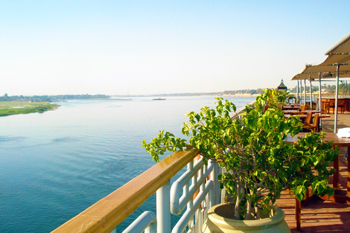 I wonder if there are crocodiles lurking in the river. I peer into the dark green water hoping to spot one. The Nile crocodile is the second largest reptile in the world, after the salt-water crocodile. They grow to up to 5 meters (16 ft) in length and weigh up to 410 kg (900 lbs). The largest on record was 61 meters (20 ft) and weighed 900 Kg (2,000 lbs). Their powerful bite and sharp conical teeth grip so firmly it is almost impossible to loosen. They are aggressive predators and will lay in wait for days waiting for the suitable moment to attack. It isn’t easy to escape. Crocodiles have been known to gallop at speeds of about 50 kilmetres (30 miles) an hour!
I wonder if there are crocodiles lurking in the river. I peer into the dark green water hoping to spot one. The Nile crocodile is the second largest reptile in the world, after the salt-water crocodile. They grow to up to 5 meters (16 ft) in length and weigh up to 410 kg (900 lbs). The largest on record was 61 meters (20 ft) and weighed 900 Kg (2,000 lbs). Their powerful bite and sharp conical teeth grip so firmly it is almost impossible to loosen. They are aggressive predators and will lay in wait for days waiting for the suitable moment to attack. It isn’t easy to escape. Crocodiles have been known to gallop at speeds of about 50 kilmetres (30 miles) an hour!
The Nile crocodile is known to attack people as well as animals. Up to 200 people a year die from crocodile encounters. I wonder, as I watch the grazing herds and passing parade of Egyptians on the shore if there might be crocodiles lying in wait for a noon-day meal.
I ask Hanan, the Egyptologist who accompanies our group, if these vicious reptiles might be lurking in the shallows. “Since the building of the Aswan Dam in 1960, the crocodiles now reside on the south side of Lake Nasser,” she assures me. I also learn that between the 1940’s and ‘60s the crocodiles were hunted for their high quality leather and this has depleted them.
Even though Hanan said there were no crocodiles in that part of the river, I keep watching in the hopes I might spot one. It isn’t until we reach Kom Ombo that, to my surprise, I discover a temple room full of them!
The Kom Ombo Temples
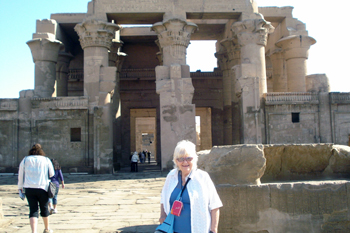 Kom Ombo is a small city once situated at the crossroads between the caravan route from Nubia and the routes from the gold mines in the eastern Sahara. During the reign of Ptolemy VI (180-145 BC) it was a training depot for African war elephants. Today Kom Ombo is the home of many Nubians who were displaced after the Aswan Dam flooded their lands.
Kom Ombo is a small city once situated at the crossroads between the caravan route from Nubia and the routes from the gold mines in the eastern Sahara. During the reign of Ptolemy VI (180-145 BC) it was a training depot for African war elephants. Today Kom Ombo is the home of many Nubians who were displaced after the Aswan Dam flooded their lands.
In ancient times, this part of the Nile River was known for the crocodiles that basked along the shore posing a threat to the locals. This is likely why one of the temples at Kom Ombo is dedicated to Sobek, the crocodile god.
The crocodile was an important symbol in ancient Egypt, both feared and revered. It was worshipped as a crocodile-headed god named Sobek. Several ancient tombs have been discovered with hieroglyphics showing a crocodile snatching a baby hippopotamus as it emerged from its mother during birth. Hippos were the only creature in the Nile who was more powerful than the crocodiles. Other tomb scenes show crocodiles mating. Sometimes they were kept in temple pools where they were fed, covered with jewelry and worshipped. When the crocodiles died, they were embalmed, mummified, placed in sarcophagi and buried in sacred tombs.
At Kom Ombo, the Egyptologist, Hanan, leads us to the archaeological site. Kom Ombo Temple is a double temple built during the Ptolemaic dynasty. It has courts, halls, sanctuaries and rooms dedicated to two sets of gods. On the right side is a temple to Sobek-Re, the crocodile god combined with the sun god Re. Sobek is associated with Set, the murderer of Osiris and enemy of Horus. In the myth, Set changed himself into a crocodile to escape Osiris wrath. The ancient Egyptians believed if they honored the crocodile as a god they would be safe from attacks by the ferocious creatures.
Sobek was an aggressive deity like the violent Nile crocodile. Yet, in spite of this, Sobek became known for his benevolence after associating with Isis as a healer of Osiris following his violent murder by Set. The name Sobek has been translated to mean “he who unites the dismembered limbs of Osiris.” He was considered a protective deity by the Egyptians. His fierceness warded off evil while defending the innocent. He was associated with pharaonic power, military prowess and fertility and in particular invoked protection against the dangers of the Nile River. For this reason the crocodile was deified and worshipped.
We enter through the remains of a monumental gate. Much of the temple has been washed away by Nile floods so only low walls and stumps of pillars in the forecourt remain. In the beautiful Outer Hypsostyle Hall, fifteen sturdy columns stand with decorated cornices and carved winged sun disk.
The left side of the temple is dedicated to the falcon god Haroeris “The Good Doctor” along with his consort Ta-Sent-Nefer, “The Good Sister. Hanan ushers us through and interprets the stories of the hieroglyphics carved on the pillars and walls. On one wall is a relief of Sobek in his snake form. Another shows Ptolemy II making offerings to various gods. On the rear wall Hanan points out a hieroglyph representing a set of surgical instruments probably carved during the Roman period.
Mummified Crocodiles!
 Finally, we enter a large room that, to my surprise, is full of crocodiles! Mummified crocodiles! It is evident from the large number displayed here that the crocodile was held in honor by the people of Kom Ombo. The museum contains crocodile eggs as well as mummified baby and adult crocodiles. Some of the mummies were found with babies in their mouths or on their backs. These ferocious beasts are known to care diligently for their young, often carrying them on their backs. By preserving them by mummification it emphasized the protective and nurturing aspects of Sobek as he protected the Egyptian people just as the crocodile protects its young.
Finally, we enter a large room that, to my surprise, is full of crocodiles! Mummified crocodiles! It is evident from the large number displayed here that the crocodile was held in honor by the people of Kom Ombo. The museum contains crocodile eggs as well as mummified baby and adult crocodiles. Some of the mummies were found with babies in their mouths or on their backs. These ferocious beasts are known to care diligently for their young, often carrying them on their backs. By preserving them by mummification it emphasized the protective and nurturing aspects of Sobek as he protected the Egyptian people just as the crocodile protects its young.
I didn’t see any live crocodiles that day, but I learned so much about the ancient Egyptians and got a new understanding of why this fierce predatory animal gained such prominence and was held in honor by the people of Kom Ombo.
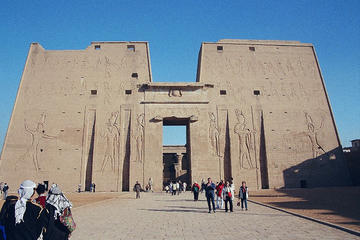
Private Day Tour Excursion To Edfu and Kom Ombo
If You Go:
♦ Kom Ombo Temple site Kom Ombo is 45 miles north of Aswan. The temple site is 4 kms from the town.
♦ Nile Cruise: I boarded the Sonesta Star Goddess at Aswan for my cruise down the Nile. This is a five-star all-suite cruise ship and the cruise lasted for 3 days between Aswan and Luxor. It included daily guided excursions with an Egyptologist guide. See http://www.Sonesta.com/nilecruises
♦ Everything you need to know about Nile Crocodiles, They are the largest species of crocodiles in Africa. They grow to about 6 metres long and can weight over 700 kgs. They almost became extinct in the 20th century and are now a protected species. Nile crocodiles are carnivores. They eat fish but prey on animals and are known to attack humans.
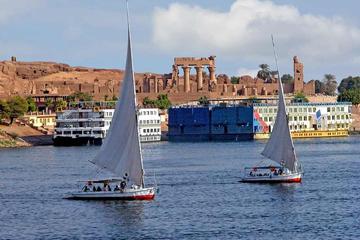
5-Day Nile Cruise: Luxor, Aswan, Kom-Ombo, Edfu from Cairo
About the author:
Ruth Kozak was thrilled to be invited to Egypt by Egyptian Tourism to write stories about this amazing country. She really did look for crocodiles along the Nile and was disappointed not so see any live ones! Ruth is both a travel journalist and historical fiction author. She is the author of: SHADOW OF THE LION: THE FIELDS OF HADES. Her first novel SHADOW OF THE LION: BLOOD ON THE MOON (volume one of two, a story of the fall of Alexander the Great’s dynasty) was published this summer by www.mediaaria-cdm.com at exactly the same time the fabled tomb at Amphipolis was uncovered. It is available on www.amazon.com or can be ordered through book stores.
Photo credits:
Crocodile by Glen Carrie on Unsplash
Photos of the Kom Ombo Temple site by W. Ruth Kozak.


